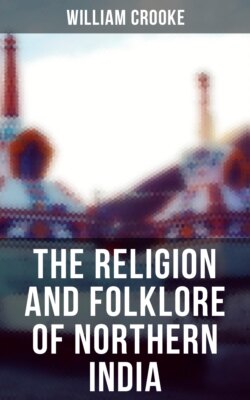Читать книгу The Religion and Folklore of Northern India - William Crooke - Страница 73
На сайте Литреса книга снята с продажи.
Other Mother Goddesses.
ОглавлениеTable of Contents
Another of these divine mothers, Mâtâ Januvî or Janamî, the goddess of births, is a sort of Juno Lucina among the Râjputs, like the Greek Ilithyia, or the Carmenta of the Romans. Her power rests in a bead, and all over Northern India midwives carry as a charm to secure easy delivery a particular sort of bead, known as Kailâs Maura, or “the crown of the sacred mountain Kailâsa.” Difficult parturition is a disease caused by malignant spirits, and numerous are the devices to cure it. The ancient Britons, we are told,64 used to bind a magic girdle, impressed with numerous mystical figures, round the waist of the expectant mother, and the jewel named Aetites, found in the eagle’s nest, applied to the thigh of one in labour, eases pain and quickens delivery. Sir W. Scott65 had a small stone, called a toad-stone, which repelled demons from lying-in women.
On the sacred plain of Kurukshetra there once stood a fort, known as Chakravyûha, and to the moderns as Chakâbu Kâ Qila, from which to the present day immense ancient bricks are occasionally dug. Popular belief ascribes great efficacy to these bricks, and in cases of protracted labour, one of them is soaked in water, which is given to the patient to drink. Sometimes an image of the fort, which is in the form of a labyrinth or maze, is drawn on a dish, which is first shown to the mother and then washed in water, which is administered to the woman. All through Nepâl and the neighbouring districts, the local rupee, which is covered with Saiva emblems, is used in the same way, and Akbar’s square rupee, known as the Châryârî, because it bears the names of the four companions (Châr-Yâr) of the Prophet, is credited with the same power. There are numerous Mantras or mystic formulæ which are used for the same purpose.
Dread famine has become a goddess under the title of Bhûkhî Mâtâ, the “hunger Mother,” who, like all the deities of this class, is of a lean and starved appearance.66 An interesting ceremony for the exorcism of the hunger Mother is recorded from Bombay. The people subscribed to purchase ten sheep, fifty fowls, one hundred cocoanuts, betel nuts, sugar, clarified butter, frankincense, red powder, turmeric, and flowers. A day previous to the commencement of the ceremony, all the inhabitants of the village, taking with them their clothes, vessels, cattle, and other movable goods, left their houses and encamped at the gate or boundary of the village. At the village gate a triumphal arch was erected, and it was adorned with garlands of flowers and mango leaves covered with red powder and turmeric. All these things are, as we shall see, well known as scarers of demons. The villagers bathed, put on new clothes, and then a procession was formed. On coming to the triumphal arch the whole procession was stopped. A hole was dug in the ground, and the village watchman put in it the head of a sheep, a cocoanut, betel nuts, with leaves and flowers. The arch was then worshipped by each of the villagers. The village watchman first entered the arch, and he was followed by the villagers with music, loud cheering, and clapping of hands. The whole party then went to the village temple, bowed to the village god, and went to their respective houses. The blood of the ten sheep and fifty fowls was offered to the village god, and the flesh was distributed among the people. A dinner was given to Brâhmans and the rite came to an end.67 The idea of the sanctity of the arch is probably based on the same principle as that of perforated stones, to which reference will be made in another connection.
Greatest of all the mother goddesses of the Râjputs is Mâmâ Devî, the mother of the gods. She is thus on the same plane as Cybele Rhea and Demeter, the Corn Mother, who gives the kindly increase of the fruits of the earth. In one of her temples she is represented in the midst of her numerous family, including the greater and the minor divinities. Their statues are all of the purest marble, each about three feet high and tolerably executed, though evidently since the decline of the art.68
